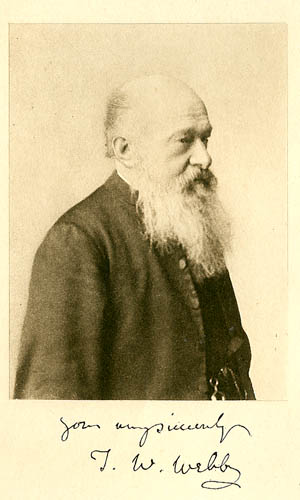
Thomas William Webb
Encyclopedia

United Kingdom
The United Kingdom of Great Britain and Northern IrelandIn the United Kingdom and Dependencies, other languages have been officially recognised as legitimate autochthonous languages under the European Charter for Regional or Minority Languages...
astronomer
Astronomer
An astronomer is a scientist who studies celestial bodies such as planets, stars and galaxies.Historically, astronomy was more concerned with the classification and description of phenomena in the sky, while astrophysics attempted to explain these phenomena and the differences between them using...
. Some sources give his year of birth as 1806. The only son of a clergyman, the Rev. John Webb, he was raised and educated by his father, his mother having died while Thomas was a small child. He went to Oxford where he attended Magdalen College
Magdalen College, Oxford
Magdalen College is one of the constituent colleges of the University of Oxford in England. As of 2006 the college had an estimated financial endowment of £153 million. Magdalen is currently top of the Norrington Table after over half of its 2010 finalists received first-class degrees, a record...
. In 1829 was ordained a minister in the Anglican Church
Church of England
The Church of England is the officially established Christian church in England and the Mother Church of the worldwide Anglican Communion. The church considers itself within the tradition of Western Christianity and dates its formal establishment principally to the mission to England by St...
. He was married to Henrietta Montague in 1843, daughter of Mr. Arthur Wyatt, Monmouth
Monmouth
Monmouth is a town in southeast Wales and traditional county town of the historic county of Monmouthshire. It is situated close to the border with England, where the River Monnow meets the River Wye with bridges over both....
. Mrs. Webb died on 7 September 1884, and after a year of declining health Thomas died on 19 May 1885.
Through his career T. W. Webb served as a clergyman at various places including Gloucester
Gloucester
Gloucester is a city, district and county town of Gloucestershire in the South West region of England. Gloucester lies close to the Welsh border, and on the River Severn, approximately north-east of Bristol, and south-southwest of Birmingham....
, and finally in 1852 was assigned to the parish of Hardwicke near the border with Wales
Wales
Wales is a country that is part of the United Kingdom and the island of Great Britain, bordered by England to its east and the Atlantic Ocean and Irish Sea to its west. It has a population of three million, and a total area of 20,779 km²...
. In addition to serving faithfully the members of his parish, T. W. Webb pursued astronomical observation
Astronomy
Astronomy is a natural science that deals with the study of celestial objects and phenomena that originate outside the atmosphere of Earth...
in his spare time. On the grounds of the vicarage or parsonage he built a small canvas and wood observatory that was home to a number of instruments, from a small 3.7" (75mm) refractor Webb acquired a number of progressively larger refractors
Refracting telescope
A refracting or refractor telescope is a type of optical telescope that uses a lens as its objective to form an image . The refracting telescope design was originally used in spy glasses and astronomical telescopes but is also used for long focus camera lenses...
and reflectors with which the observations in the guide were made. The largest telescope was a 9-1/3" (225mm) silver on glass reflector used from 1866 until his last observation in March 1885. It was at Hardwick that he wrote his classic astronomical observing guide Celestial Objects for Common Telescopes (2 vol
Volume
Volume is the quantity of three-dimensional space enclosed by some closed boundary, for example, the space that a substance or shape occupies or contains....
s) in 1859 for which he is best known today. This two volume work was written as a guide for the amateur astronomer, containing instructions on the use of a telescope as well as detailed descriptions of what could be observed with it. This work became the standard observing guide of amateur astronomers worldwide, and remained so until well into the 20th Century, gradually supplanted by more modern guides such as Burnham's
Robert Burnham, Jr.
Robert Burnham, Jr. was an American astronomer. He is best known for writing the classic three-volume Burnham's Celestial Handbook.-Early work:...
Celestial Handbook.
The title's reference to "common telescopes" refers to refractors of 3 to 6 inches and the somewhat larger reflectors that were commonly available to the amateur observers of the day.
Celestial Objects for Common Telescopes was first published in 1859. It was continually published through the 6th edition in 1917 revised by Rev. T. E. Espin
T. H. E. C. Espin
The Reverend Thomas Henry Espinell Compton Espin or T. H. E. C. Espin was a British astronomer. His father Thomas Espin was Chancellor of the Diocese of Chester....
. In 1962, the reprinted edition was published by Dover Publications
Dover Publications
Dover Publications is an American book publisher founded in 1941 by Hayward Cirker and his wife, Blanche. It publishes primarily reissues, books no longer published by their original publishers. These are often, but not always, books in the public domain. The original published editions may be...
, Inc., edited and revised by Margaret W. Mayall
Margaret Mayall
Margaret Mayall was an American astronomer. She was the director of the American Association of Variable Star Observers from 1949 to 1973. In 1958 she won the Annie J. Cannon Award in Astronomy. Her husband was Newton Mayall.-External links:...
. The 1962 edition is still readily available and widely used, while earlier editions have become collectors items and are quite rare.

